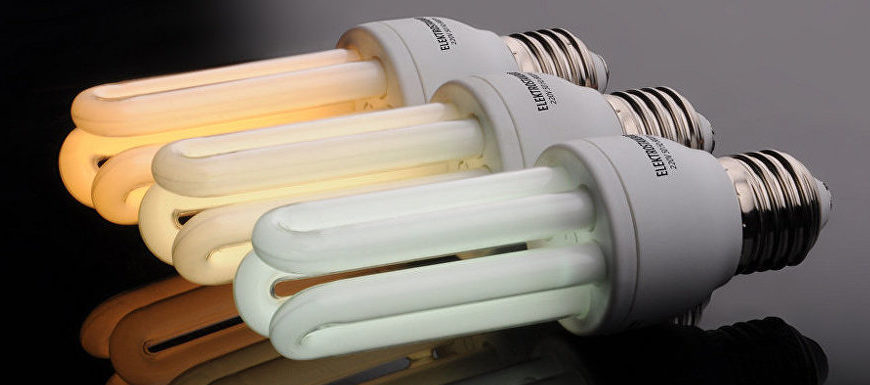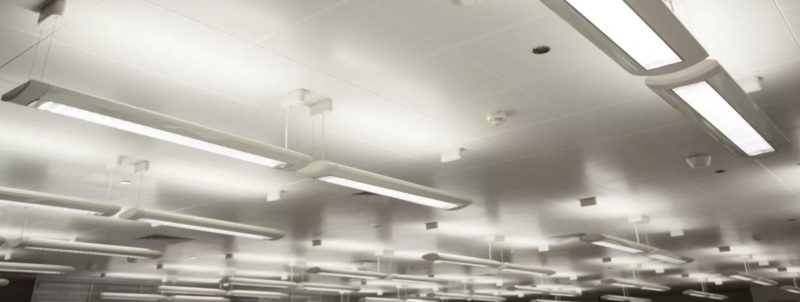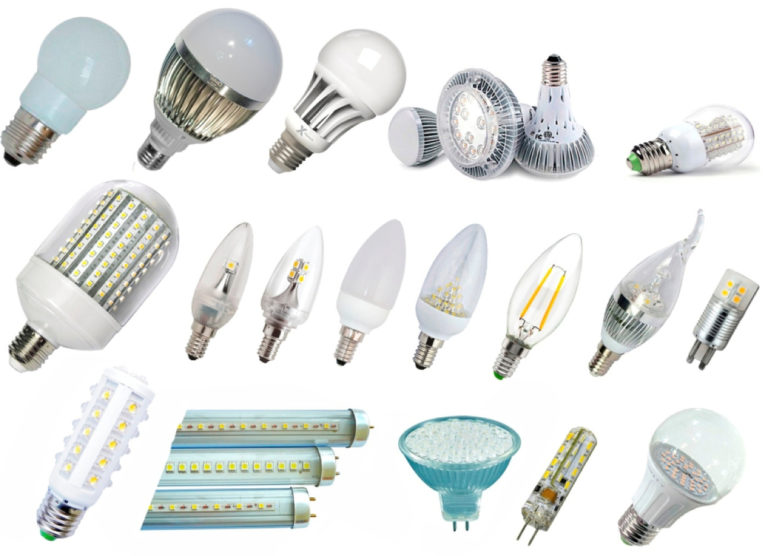Description of the fluorescent light bulb
Fluorescent lamps (LL) appeared on the market a long time ago. Manufacturers did not follow standards for a long time, which, due to the simplicity of design, had almost no effect on the quality of lighting fixtures. Now the LL market has become manageable and modern products meet certain standards. They are able to provide the necessary light flux and at the same time are characterized by economical energy consumption.
What is a fluorescent lamp
The low efficiency of traditional incandescent lamps has long been a headache for manufacturers of electrical equipment. The problem of saving energy was becoming more and more urgent, and in 1936 a solution was proposed. In Russia, special gas-discharge devices capable of combining lighting with energy saving appeared.
A fluorescent lamp is a construction of a bulb with electrodes placed inside. The shape can be any shape, only the composition of the gas affects the operation. When a voltage is applied between the electrodes, a process of electron emission is triggered, which creates radiation.

However, the radiation produced at this stage is in the ultraviolet range and is not visible to the human eye. To make the light visible, the top of the bulb is coated with a special compound - a phosphor.
Inside the bulb is inert gas or mercury vapor to maintain a glow discharge between the electrodes. Inert gas is a safe option because it does not interact with the environment. But devices with mercury vapor are extremely dangerous. Devices with such content must be disposed of according to all the rules, and care must be taken when handling the bulbs.
Types of Fluorescent Lamps
All fluorescent lamps are usually divided into two large groups: high-pressure and low-pressure devices.
High-pressure devices are often used in street lamps. They are able to produce a strong luminous flux, but the color rendering parameters are at a low level. Lamps with different levels of light output and shades of luminescence can be found on sale. They are used for powerful lighting, as decorative illumination of buildings.

Low-pressure LL are more common. They are widely used in everyday life and in industry. Most often the models are in the form of small cylinders. Such appliances have control gear, which reduces the pulsation coefficient and makes the glow more uniform. The component is a small circuit placed in the base of the bulb.
Labeling and dimensions
Each LL has its own technical characteristics, which determine its application. Usually all information about the device is encoded in the marking.
The designation begins with the letter L, which stands for lamp. Then comes the letter designation of the shade.
| Marking | Meaning |
|---|---|
| Д | daylight |
| Б | white light |
| HB | cold white |
| TB | warm-white |
| Е | natural light |
| HE | cold natural light |
| D, C, H, G, R | different shades, depending on the type of gas used and the phosphor used |
Sometimes in the marking you can find the designation C or CC, which indicates an improved color rendering of phosphor. For example, the designation LDC is typical for a daylight lamp with improved color rendering.
This is followed by the numerical designations which follow the global standards. They are three digits, the first of which specifies the color rendering quality, and the others indicate a specific color temperature. The higher the first digit, the better the color rendering. The higher the other digits, the cooler the luminescence.

LL devices are differentiated by size. The size designation "TX" is responsible for the dimensions, where X is the specific size parameter. Specifically, T5 stands for 5/8-inch diameter and T8 stands for 8/8-inch diameter.
Plinths can be pin or threaded. In the first case the designation is of the form G23, G24, G27 or G53. The number indicates the distance between the pins. Threaded bases are marked E14, E27 and E40. Here the number defines the diameter of the thread.
Additionally, the supply voltage and starting method. If the box has the designation RS - then no additional equipment is required to work. All the necessary elements are already built into the socket.
Power and spectrum
In order for the light source could work properly, it must be connected to a network of 220 V with a frequency of 50 Hz. Deviations can adversely affect the stability of lighting, significantly reducing the service life.
Voltage fluctuations can change the power of an electrical device, reducing its efficiency. Even the most powerful lamp will shine weakly if there is a lack of voltage.
Watch out: Beginning in 2020, there will be a ban on fluorescent bulbs.
Modern LLs come in virtually all shades. The color temperature spectrum varies from classic warm to daylight. By shade, each lamp is labeled accordingly.
Separately, it is worth considering lighting devices with ultraviolet glow. They are denoted by the LUF mark, while the devices of reflective blue are marked LSR. UV lamps are used for bactericidal treatment rooms.
Most fluorescent bulbs produce a spectrum similar in length to normal sunlight. You can see the similarity between the spectra in the picture below.

The spectrum of sunlight is shown on the left and the spectrum of a quality fluorescent lamp is shown on the right. The sunlight has a more even characteristic, but there are definitely similarities. The LL has a pronounced peak in the green region, while there is a drop in the red region.
It has been scientifically proven that the closer the light from an artificial source to natural light, the healthier it is. For this reason, fluorescent lamps are preferable to LED devices.
What applications are there
Fluorescent lamps can effectively illuminate large areas while significantly improving indoor conditions, reducing energy costs, and extending the life of the lighting system.
Devices with a built-in electronic ballast and E27 or E14 screw bases are used as effective replacements for incandescent lamps. They are able to provide the necessary light flux, ensure stability and flicker-free operation. There is absolutely no hum. They are used in apartments, houses, shopping centers, schools, hospitals, banks, etc.

Specifications
The technical specifications of a particular lighting fixture are encoded in the marking and indicated on the packaging. This is information about the power of the lamp, the type of socket, size, color temperature, life span.
Most modern fluorescent fixtures are capable of working 8-12 thousand hours. The figure depends on the type and size of the device.
The efficiency is expressed by the index of 80 Lm/W, which is significantly higher than that of traditional incandescent lamps. During operation, a moderate amount of heat is emitted, the devices are wind-resistant, capable of stable operation at temperatures from +5 to +55 °C. If a heat-resistant coating is present, the device can be used at +60 °C.

The color temperature is usually between 2,700 and 6,000 K. The efficiency can be up to 75%.
How the lamp works
The principle of any fluorescent lamp involves applying voltage to the electrodes inside the bulb. A glow discharge occurs between the electrodes, which is maintained by the inert gas or mercury vapor inside the bulb.

The glow discharge generates radiation in the ultraviolet range which is transformed by the phosphor deposited on the bulb into visible light of the desired color.
In order to produce ultraviolet radiation, the following are used discharge lamps. Normal glass does not transmit ultraviolet, so for the manufacture of the bulb uses special quartz glass. Luminophore coating in this case is absent. Devices are widely used in solariums and in the disinfection of rooms.
Why do you need a choke in a fluorescent lamp
The standard connection diagram of a fluorescent lamp includes the light source itself, a starter and a choke.
Choke is an inductor coil with a lamellar core. It acts as a ballast to stabilize the voltage and keep the lamp from failing quickly.
The starter receives a considerable voltage when it is switched on, several times the voltage required by the lamp. The choke reduces this voltage and only then supplies the contacts of the luminaire.

This diagram can be completed by a capacitor connected in parallel with the lamp. in parallel to the power supply, which greatly increases the stability of the system, prolongs the service life and reduces flicker.
How to choose the right one
When choosing a fluorescent lamp, you need to pay attention to:
- temperature mode of use;
- voltage;
- size;
- the strength of the luminous flux;
- Lighting temperature.
In the home, devices with a threaded base and minimal flicker are effective.

Hallways need a strong light, so choose lamps with an intense light flux. But in the bedroom or living room compact devices with soft muted light are appropriate.
In the kitchen, it is better to use multi-level lighting, which includes general and local devices. It is desirable to choose warm shades with a power of at least 20 watts.
Disposal of the lamp
Fluorescent bulbs contain substances that are harmful to the environment, so the disposal of waste should be treated as responsibly as possible.
One lamp can contain about 70 mg of mercury, which is quite dangerous. However, there are a lot of such lamps in landfills, it is a serious problem.
Mercury entering the human or animal body quickly causes poisoning. It is forbidden to keep faulty lamps in the house for a long time because of the possibility of mechanical damage to the bulb with subsequent leakage of harmful substances.

- All lamps are collected and stored in special containers.
- The devices are crushed by means of a press.
- The resulting crumbs are sent to the heat treatment chamber.
- Harmful substances fall into the filter, where they remain.
Sometimes the gases are exposed to liquid nitrogen and solidify. The resulting mercury is reused.
Advantages and disadvantages of lamps
Like other sources of lighting, fluorescent lamps have advantages and disadvantages that are advisable to consider.




